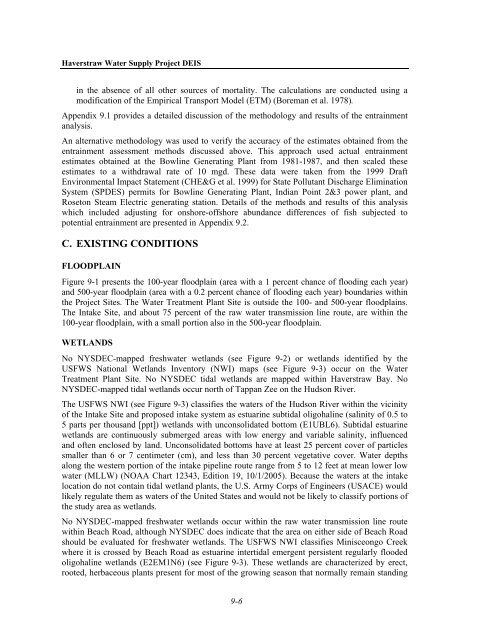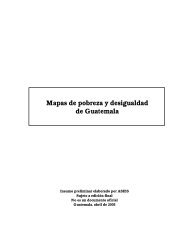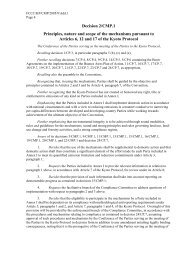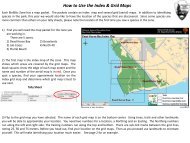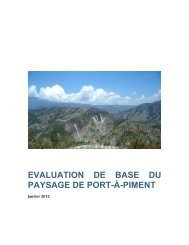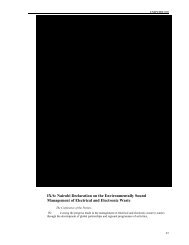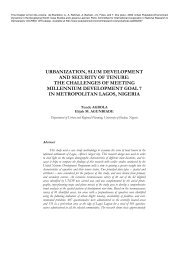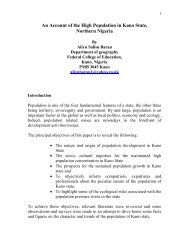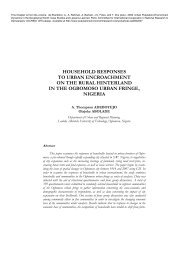Haverstraw Water Supply Project DEIS
Haverstraw Water Supply Project DEIS
Haverstraw Water Supply Project DEIS
Create successful ePaper yourself
Turn your PDF publications into a flip-book with our unique Google optimized e-Paper software.
<strong>Haverstraw</strong> <strong>Water</strong> <strong>Supply</strong> <strong>Project</strong> <strong>DEIS</strong>in the absence of all other sources of mortality. The calculations are conducted using amodification of the Empirical Transport Model (ETM) (Boreman et al. 1978).Appendix 9.1 provides a detailed discussion of the methodology and results of the entrainmentanalysis.An alternative methodology was used to verify the accuracy of the estimates obtained from theentrainment assessment methods discussed above. This approach used actual entrainmentestimates obtained at the Bowline Generating Plant from 1981-1987, and then scaled theseestimates to a withdrawal rate of 10 mgd. These data were taken from the 1999 DraftEnvironmental Impact Statement (CHE&G et al. 1999) for State Pollutant Discharge EliminationSystem (SPDES) permits for Bowline Generating Plant, Indian Point 2&3 power plant, andRoseton Steam Electric generating station. Details of the methods and results of this analysiswhich included adjusting for onshore-offshore abundance differences of fish subjected topotential entrainment are presented in Appendix 9.2.C. EXISTING CONDITIONSFLOODPLAINFigure 9-1 presents the 100-year floodplain (area with a 1 percent chance of flooding each year)and 500-year floodplain (area with a 0.2 percent chance of flooding each year) boundaries withinthe <strong>Project</strong> Sites. The <strong>Water</strong> Treatment Plant Site is outside the 100- and 500-year floodplains.The Intake Site, and about 75 percent of the raw water transmission line route, are within the100-year floodplain, with a small portion also in the 500-year floodplain.WETLANDSNo NYSDEC-mapped freshwater wetlands (see Figure 9-2) or wetlands identified by theUSFWS National Wetlands Inventory (NWI) maps (see Figure 9-3) occur on the <strong>Water</strong>Treatment Plant Site. No NYSDEC tidal wetlands are mapped within <strong>Haverstraw</strong> Bay. NoNYSDEC-mapped tidal wetlands occur north of Tappan Zee on the Hudson River.The USFWS NWI (see Figure 9-3) classifies the waters of the Hudson River within the vicinityof the Intake Site and proposed intake system as estuarine subtidal oligohaline (salinity of 0.5 to5 parts per thousand [ppt]) wetlands with unconsolidated bottom (E1UBL6). Subtidal estuarinewetlands are continuously submerged areas with low energy and variable salinity, influencedand often enclosed by land. Unconsolidated bottoms have at least 25 percent cover of particlessmaller than 6 or 7 centimeter (cm), and less than 30 percent vegetative cover. <strong>Water</strong> depthsalong the western portion of the intake pipeline route range from 5 to 12 feet at mean lower lowwater (MLLW) (NOAA Chart 12343, Edition 19, 10/1/2005). Because the waters at the intakelocation do not contain tidal wetland plants, the U.S. Army Corps of Engineers (USACE) wouldlikely regulate them as waters of the United States and would not be likely to classify portions ofthe study area as wetlands.No NYSDEC-mapped freshwater wetlands occur within the raw water transmission line routewithin Beach Road, although NYSDEC does indicate that the area on either side of Beach Roadshould be evaluated for freshwater wetlands. The USFWS NWI classifies Minisceongo Creekwhere it is crossed by Beach Road as estuarine intertidal emergent persistent regularly floodedoligohaline wetlands (E2EM1N6) (see Figure 9-3). These wetlands are characterized by erect,rooted, herbaceous plants present for most of the growing season that normally remain standing9-6


